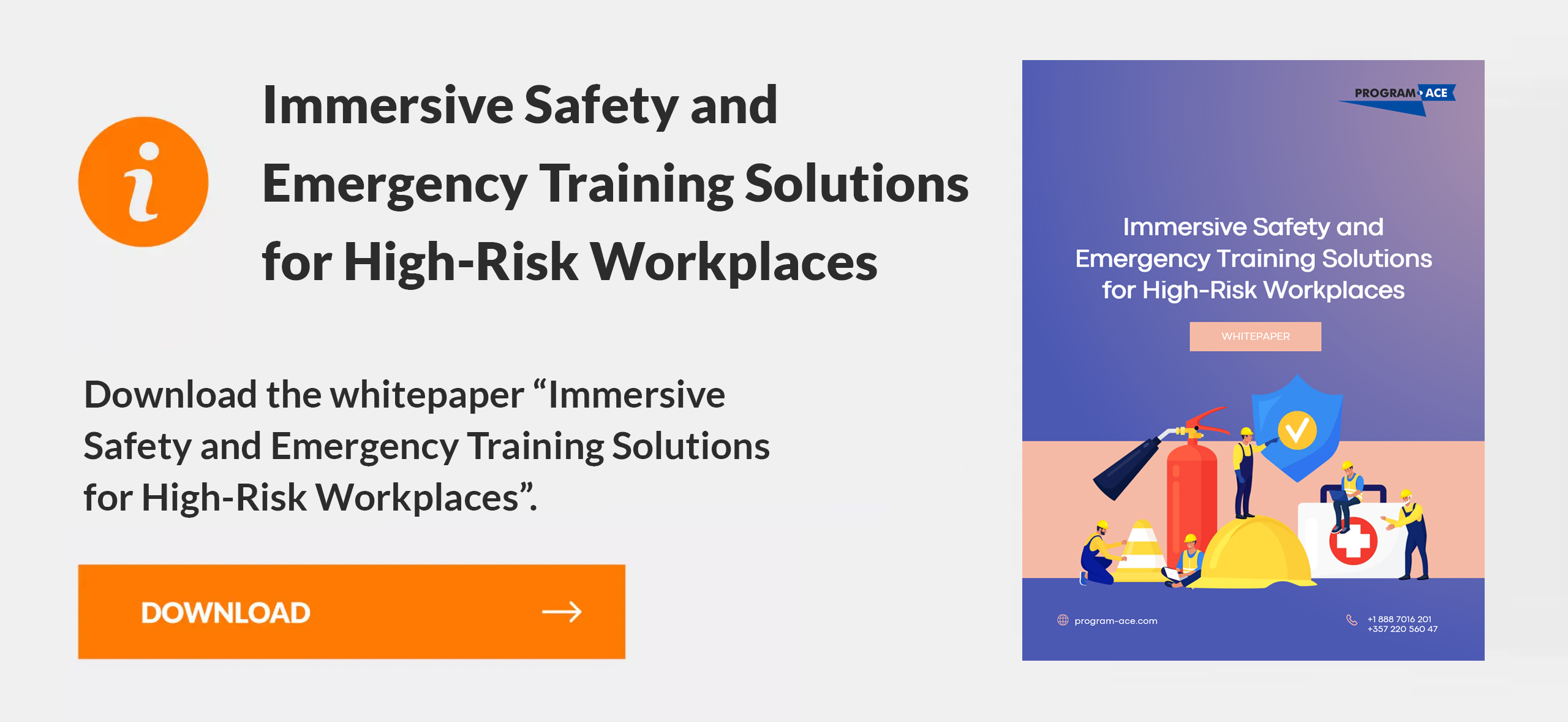Virtual technical skills training gives your organization a direct way to close skill gaps while preparing teams for everyday tasks. Our specialists create programs that move beyond passive learning and focus on real application. When your employees enter digital training environments, they can practice coding, operating systems, or handling specialized tools in conditions that match their actual work. The result is training that feels practical and immediately relevant.
Our team builds hard skills training solutions that replace generic sessions with targeted learning. Based on our experience, employees absorb information faster when content is structured around real business needs. Interactive solutions allow them to test knowledge step by step, and your managers receive precise data about progress. Every participant moves forward at the right pace without slowing down others.
For your company, the benefits extend across the workforce. New hires can get the same consistent preparation as long-standing staff who require updates. With our methodology, you can scale learning efficiently and measure its direct impact on productivity, compliance, and long-term growth.
Why Immersive Technical Skills Training Matters Today

Workplaces rely on employees who can confidently handle specific tools, software, and processes. Our experts design training that focuses on direct application rather than abstract theory, ensuring that your staff can immediately use new skills at work. The need for such preparation grows daily as technology updates faster than traditional learning methods can keep pace.
Industry recognition confirms that immersive formats result in faster retention, stronger engagement, and better outcomes compared to conventional static instruction. For your organization, this means improved performance without long delays in workforce readiness.
Different industries face unique challenges when it comes to workforce preparation. Technical skills training ensures employees can operate with accuracy, follow strict safety standards, and adapt to specialized processes. In the table below, we highlight how such training directly benefits sectors where precision, compliance, and risk management are crucial.
| Industry | How Technical Skills Training Helps |
| Manufacturing | Employees practice precision tasks like machine calibration, quality inspection, and advanced assembly in controlled virtual settings. Training reduces errors, prevents downtime, and ensures consistent production standards. Workers gain confidence with complex machinery while companies lower risks tied to equipment misuse. |
| Oil & Gas | High-risk environments demand strict safety and operational knowledge. Training programs prepare employees for hazard recognition, emergency shutdowns, and safe handling of equipment. Virtual practice reduces accident rates and supports compliance with international regulations. This leads to greater safety and cost savings across operations. |
| Energy & Utilities | Workforce readiness is critical in power plants, renewable energy facilities, and utility networks. Training helps staff master equipment maintenance, outage response, and regulatory compliance. Employees rehearse fault detection and emergency recovery procedures, ensuring continuity of service. Companies benefit from fewer disruptions and stronger operational reliability. |
| Construction | Workers face safety risks daily on active sites. Training covers proper use of protective gear, crane operation, equipment handling, and hazard prevention. Employees learn to follow safety codes precisely, reducing accidents and delays. Organizations see improved project delivery times, fewer injuries, and stronger compliance with safety standards. |
By aligning training solutions with industry demands, organizations reduce operational risks, improve compliance, and maintain consistent performance. Tailored technical training not only protects employees but also strengthens overall efficiency and business reliability.
Understanding Virtual Technical Skill Training in a Modern Context
Our team approaches virtual training as a way to blend efficiency with measurable outcomes. Hard skills training introduces employees to concrete knowledge, such as coding practices, data analysis, and machine operation, through interactive solutions.
User feedback confirms that digital sessions reduce confusion and shorten the time needed for skill acquisition. Unlike broad seminars, virtual formats enable your company to tailor each program to the specific requirements of your actual workplace. Specialists on our team ensure that the design remains practical, accessible, and scalable across different employee groups.
Defining Technical Skill Training Clearly
Technical skill training refers to structured instruction that equips employees with direct, role-specific knowledge. Instead of covering generic subjects, it centers on the exact tasks an employee must perform, from writing secure code to handling specialized equipment. Our expertise shows that clarity in defining objectives prevents wasted time and improves knowledge transfer.
A few core elements shape effective programs:
- Specific focus. Each course targets one domain without unnecessary additions.
- Practical design. Exercises simulate real tasks employees encounter.
- Measured outcomes. Performance tracking provides clear evidence of progress.
Your business benefits when staff know precisely what they will learn and how it connects to daily responsibilities. Our methodology ensures that technical training is not just informative but also operationally relevant, helping teams achieve consistent improvements in productivity and quality.
The Shift from General Skills to Targeted Expertise
Organizations once relied heavily on general workplace training, covering broad subjects that lacked direct impact. Today, immersive training aligns each program with precise business goals. Practical experiments have confirmed that employees learn more effectively when instruction reflects the tools and platforms they actually use.
The main differences between past approaches and modern targeted methods include:
- Scope. Old training addressed broad topics, while targeted models focus narrowly on tasks.
- Application. General skills remained theoretical, but targeted sessions involve hands-on practice.
- Value. Outcomes are now tied to measurable business improvements rather than abstract knowledge.
Our research demonstrates that this transition strengthens organizational agility. When your workforce develops specific expertise, projects move forward with fewer errors, and overall efficiency rises. Finally, argeted expertise reduces onboarding time and enhances long-term retention compared to outdated approaches.
Why Businesses Prioritize Technical Skills More Than Ever
Modern operations demand accuracy, speed, and compliance. Specialists on our team deliver training programs that help employees meet these expectations without delay. The data we collected proves that companies emphasizing technical skills report shorter project cycles and lower error rates.
Several factors explain this shift:
- Rapid innovation. Technology evolves too quickly for broad training to keep up with it.
- Industry standards. Compliance requires precise knowledge across regulated sectors.
- Competitive pressure. Businesses must deliver faster results to maintain relevance.
Your organization cannot afford knowledge gaps when efficiency depends on advanced expertise. Partner feedback indicates that targeted training enhances workforce confidence and yields measurable returns on investment. As confirmed by our clients, prioritizing technical skills is a necessary operational requirement.
The Pros of Technical Skills Training for Employees

Technical training has a direct impact on how employees perform and how engaged they feel at work. Our team has observed that when staff receive structured instruction tailored to their responsibilities, they become more confident in completing tasks and less dependent on constant oversight. Your company benefits from workers who maintain consistency, adapt to new challenges faster, and view professional growth as part of their role. The outcome is a workforce that is both more capable and more motivated to stay long-term.
Improving Productivity Through Specialized Knowledge
Specialized knowledge directly accelerates performance. In our professional work, we have found that productivity rises when employees no longer waste time searching for solutions or guessing next steps. Instead, they act with precision.
Three significant productivity gains stand out:
- Quicker turnaround. Projects move forward faster with fewer interruptions.
- Fewer dependencies. Employees handle more tasks independently.
- Better allocation. Managers spend less time on corrections and more on strategy.
Measured improvements illustrate that these gains remain consistent months after training is complete. For your business, this means productivity levels that can be forecasted, scaled, and sustained without risk of sudden decline.
Reducing Errors and Operational Risks
Errors and risks drain time, money, and trust. We've noticed that technical training significantly reduces mistakes by providing staff with step-by-step clarity. Workers no longer rely on trial and error, which stabilizes processes.
Consider the most important results:
- Reduced rework. Correct outputs save hours that would have been spent fixing mistakes.
- Compliance ensured. Training prepares employees for industry standards.
- Safer workflows. The risk of accidents decreases when staff follow proven methods.
- Cost avoidance. Operational disruptions decrease, preventing financial losses.
Therefore, fewer risks imply smoother projects and stronger trust with partners. When staff are confident in their knowledge, error prevention becomes an integral part of their daily routines, rather than a separate goal.
Strengthening Employee Retention and Morale
Retention depends on whether employees feel valued. According to our internal analysis, structured training programs send a strong message of support. Staff view investment in their skills as an investment in their future, and morale naturally improves.
Positive influences include:
- Job fulfillment. Employees appreciate training that is relevant to their actual tasks.
- Career clarity. Clear growth paths increase motivation to stay.
- Team cohesion. Shared learning experiences create stronger collaboration.
- Loyalty built. Workers remain committed to a company that invests in them.
Partner feedback indicates that morale has a direct correlation with employee retention. That’s why well-trained employees not only stay longer but also bring energy and initiative into every project.
How to Train Technical Skills Effectively
Practical training requires methods that not only explain theory but also simulate real-world work. Simulation training is a strong approach here because employees can practice without causing operational disruptions. Beyond that, effective strategies combine multiple formats, such as structured lessons, digital modules, and guided practice, into a coherent and unified process. Your business gains the most when training is consistent, scalable, and aligned with the tools and systems employees actually use every day.
Classroom vs. On-the-Job Approaches
Organizations often face a choice between traditional classrooms and workplace-based learning. Each has value, but the results differ depending on context.
| Aspect | Classroom Training | On-the-Job Training |
| Control | Standardized, same for everyone. | Varies with supervisor quality. |
| Environment | Safe, low-pressure, theoretical. | Real work conditions, high-pressure. |
| Application | Limited practice, mostly examples. | Direct practice on live tasks. |
| Scalability | Easy to roll out widely. | Harder to scale across teams. |
Neither format alone fully meets modern requirements. Many companies now blend the two — classroom settings for foundational knowledge, followed by structured on-the-job sessions for practical reinforcement. That combination ensures both consistency and direct applicability in daily workflows.
Leveraging Digital Platforms for Scalable Learning
Digital platforms expand training reach without diluting quality. Online modules, VR sessions, and mobile-friendly lessons mean your workforce can learn anytime, anywhere. Unlike traditional setups, these platforms collect precise data on progress, so managers see not only completion rates but also actual performance levels.
Unique advantages are:
- Scalability. One course reaches hundreds or thousands of employees.
- Adaptability. Modules can be updated quickly when tools or processes change.
- Flexibility. Employees access training at their own pace.
- Measurability. Tracking dashboards highlight individual and group performance.
So, digital delivery ensures that training investments stay relevant as technologies evolve. When combined with hands-on practice, digital platforms create a balanced approach that keeps workforce growth aligned with the industry's pace.
Coaching and Mentorship Models That Work
Some skills cannot be mastered through courses alone. Coaching and mentorship provide the personalized guidance employees need to refine technical expertise. Instead of one-size-fits-all instruction, staff work directly with experienced colleagues or external experts.
Three models are most effective:
- Peer mentorship. Senior employees guide juniors through specific tasks and projects.
- Rotational coaching. Workers learn from different experts across departments.
- Dedicated mentorship. A single mentor supports an employee's growth over time.
Such models create stronger professional bonds and faster skill transfer. Employees learn not only how to perform tasks but also how to troubleshoot and adapt under pressure. For your company, mentorship ensures continuity, while knowledge doesn't stay locked in one individual but spreads across teams, protecting against skill shortages.
Virtual Technical Skills Development Training in Different Industries
Our team develops training programs tailored to specific industries, rather than generic templates. Each field requires distinct approaches to technical accuracy, compliance, and adaptability. By tailoring learning experiences, we help your organization reduce risks, improve productivity, and keep employees engaged with the skills that matter most in their daily work. From engineering to healthcare, virtual training ensures that knowledge transfer stays relevant and measurable, regardless of the sector.
Manufacturing and Engineering for Technical Precision

Manufacturing lines and engineering projects rely on absolute accuracy. Even small mistakes lead to downtime, defective products, or safety hazards. Virtual training offers controlled scenarios where employees can refine precision without risking costly equipment.
A closer look at what staff actually practice:
- Machine calibration. Trainees adjust virtual equipment until readings align with exact tolerances, ensuring they learn fine control rather than broad approximations.
- Assembly accuracy. Workers rehearse detailed sequences, assembling components virtually until they can repeat them without error.
- Defect recognition. Simulated products present subtle flaws, teaching staff how to identify problems quickly before they reach customers.
- Maintenance procedures. Employees disassemble and repair digital machinery, practicing safe routines that would otherwise require expensive shutdowns.
By combining repetition with immediate feedback, training creates habits that transfer directly to real machinery. Staff approach technical processes with confidence, resulting in smoother operations and higher reliability.
IT and Software Keeping Up With Rapid Change

IT teams face constant updates in languages, frameworks, and security protocols. A static training manual cannot keep pace with this speed. Virtual labs and digital platforms allow developers and administrators to stay current by practicing in environments that mirror live systems.
The essential capabilities shaped through this approach:
- Rapid adaptation. Staff rehearse version upgrades in sandboxed systems, learning new interfaces before deployment.
- Security awareness. Interactive modules replicate phishing attempts or malware intrusions, forcing users to make quick decisions that reduce vulnerabilities.
- Collaborative testing. Teams solve coding challenges in shared environments, preparing them for real-world project collaboration.
- System recovery. Trainees restore simulated servers after crashes, strengthening their ability to handle emergencies under pressure.
Each exercise directly connects to the challenges that technical teams encounter daily. Instead of reactive fixes, employees learn to anticipate issues and implement solutions before they disrupt operations.
Healthcare Training for Accuracy and Compliance

Healthcare workers require training that strikes a balance between technical skills and regulatory precision. Traditional instruction often lacks the necessary immediacy in urgent scenarios, but virtual simulations create conditions where staff can rehearse both procedures and decision-making.
Practical areas where employees build confidence:
- Emergency intervention. Trainees manage cardiac arrest cases virtually, practicing both the timing and coordination of their responses to these critical situations.
- Regulation practice. Modules guide staff through compliance with HIPAA, GDPR, or other relevant standards, demonstrating how these rules apply in daily interactions.
- Equipment handling. Virtual replicas of diagnostic tools or surgical devices provide staff with a safe environment to practice using them before handling actual equipment.
- Patient scenarios. Simulated conversations help practitioners enhance their communication skills, from delivering sensitive news to obtaining informed consent.
Through repeated exposure, healthcare employees not only refine techniques but also reduce stress when faced with real patients. The result yields improved accuracy, increased confidence, and decreased risk of regulatory breaches.
Immersive Technical Skills Training Examples That Deliver Results
Practical outcomes matter more than abstract promises. Our team develops immersive technical skills programs designed to solve concrete challenges, from protecting sensitive data to preparing staff for risky environments. Each example demonstrates how targeted design supports measurable improvements, whether in cybersecurity, analytics, or safety-critical operations. By presenting your employees with real-world scenarios instead of theory, training ensures they retain knowledge and perform more effectively under pressure.
Cybersecurity Upskilling for Data Protection
Data breaches often occur because employees are unprepared to recognize and respond to threats. Virtual programs make cybersecurity more than just policy memorization by simulating real attacks in a safe environment. Staff face phishing attempts, malware intrusions, and password exploits, learning the right actions step by step.
Different training layers build complete readiness:
- Awareness drills. Employees identify deceptive emails, suspicious links, and social engineering tactics.
- Incident response. Staff practice containment measures, such as isolating infected systems or reporting breaches.
- Policy application. Programs reinforce how company protocols apply in urgent moments, not just during audits.
- Recovery skills. Trainees rehearse system restoration and communication after simulated incidents.
Such solutions turn theory into habits. Instead of waiting for external IT to solve problems, employees actively defend systems, reducing the chance of costly security failures.
Advanced Analytics Programs for Decision-Making
Analytics drives business decisions, but many employees lack confidence in interpreting data. Virtual learning training removes this barrier by creating guided practice with real datasets in interactive environments. Staff progress from basic dashboards to advanced predictive modeling through exercises that adjust to their skill level.
Some components of effective analytics training encompass:
- Data interpretation. Employees learn to extract insights from charts and reports without misreading trends.
- Scenario modeling. Trainees test their decisions against simulated outcomes, building intuition for the business impact.
- Tool mastery. Staff explore BI platforms, machine learning solutions, and visualization software in structured exercises.
- Critical reasoning. Training emphasizes not only producing numbers but also questioning their reliability.
By connecting analytics programs to actual decision-making, employees develop skills that shape strategy rather than just reporting. The outcome is a workforce capable of using data confidently in high-stakes contexts.
AR/VR Training for High-Risk Environments
High-risk tasks cannot always be practiced safely in reality. AR and VR training overcome this limitation by replicating conditions that would otherwise put employees at risk. From climbing towers to handling hazardous materials, trainees learn procedures without exposing themselves or equipment to danger.
Distinct advantages emerge across industries:
- Safe exposure. Employees rehearse dangerous tasks without real-world consequences.
- Muscle memory. Repeated practice in simulated spaces prepares staff for physical accuracy.
- Error tolerance. Mistakes become learning opportunities instead of accidents.
- Confidence boost. Workers approach high-pressure environments calmly, knowing they've trained extensively.
AR adds digital guidance to real settings, while VR creates fully simulated spaces. Together, they build competence in industries where error margins are nearly zero.
Measuring the ROI of Virtual Technical Skills Training
Return on investment is a crucial measure for any training initiative. Our team focuses on creating programs that deliver tangible outcomes instead of vague improvements. When your organization invests in virtual technical skills training, results can be tracked with precision, from cost savings to productivity increases. Understanding how to measure these returns makes it easier to refine strategies and demonstrate the value of continued learning initiatives.
Metrics That Show Performance Gains
Clear measurement tools prove whether training delivers results. Instead of relying on subjective opinions, organizations can use performance data to evaluate their progress.
The metrics often reviewed are:
- Task completion time. How quickly employees finish assignments after training.
- Error reduction. The percentage decrease in mistakes across workflows.
- Compliance rates. Improved adherence to safety or industry regulations.
- Knowledge test results. Scores showing retained understanding of procedures.
- Productivity benchmarks. Output levels are compared before and after training.
- Support tickets. Decline in requests for technical help or corrections.
When compared against previous baselines, these indicators show whether programs directly improve workforce efficiency. Many companies pair such technical measures with soft skills training assessments to create a complete picture of performance growth.
Tracking Employee Engagement and Knowledge Retention
Measuring ROI goes beyond statistics. Employee engagement determines whether training is practical, and knowledge retention ensures that the lessons remain useful over time. Observation, feedback surveys, and follow-up assessments are strong ways to assess this. Employees who stay engaged during training display curiosity, ask questions, and apply new skills with confidence.
When retention is strong, those skills stay embedded in daily tasks months after the training concludes. Tracking these qualities requires ongoing attention rather than one-time evaluation. Success is evident when staff naturally integrate newly acquired skills into routines, demonstrating that learning has become a practical part of their role.
Long-Term Organizational Benefits Beyond Cost Savings
Financial efficiency is one measure of ROI, but training creates additional benefits that extend far beyond the balance sheet.
- Reduced turnover. Employees tend to stay longer when they see opportunities for growth.
- Knowledge continuity. Skills are shared across teams, avoiding gaps when staff leave.
- Improved safety. Fewer accidents occur when procedures are mastered thoroughly.
- Operational consistency. Standardized training keeps practices aligned across departments.
- Innovation capacity. Skilled teams generate new ideas and implement them faster.
Each of these benefits compounds over time, reinforcing the initial investment. Virtual training shifts from being a short-term program to a long-term foundation that supports organizational resilience and competitiveness.
How to Overcome Barriers in Implementing Technical Skills Training
Organizations often recognize the need for technical training, but they face obstacles in implementing it. Challenges can stem from financial limits, employee reluctance, or mismatched learning methods. Addressing these barriers directly ensures training programs are both practical and sustainable, rather than theoretical goals that never reach full implementation.
Address Budget and Resource Constraints
Budgets can limit training options, but financial constraints do not have to stop development efforts. Companies that struggle with costs often benefit from a phased implementation approach, where training begins with the most critical skills and expands gradually. Shared platforms and remote solutions also reduce travel and venue expenses, making training more accessible across different locations.
Another vital approach is measuring returns as early as possible. When leaders see evidence of efficiency improvements or reduced errors, they become more willing to allocate funds. Planning carefully and choosing scalable solutions enables the achievement of results without overwhelming budgets.
Handle Employee Resistance to Change
Employees sometimes resist new training because they fear disruption or doubt its value. Overcoming this barrier requires transparency about why training matters and how it benefits daily work. Explaining the connection between training and real job performance helps reduce skepticism.
Involving employees early, allowing them to share feedback, and providing clear examples of positive outcomes fosters trust and acceptance. Managers also play a central role by modeling enthusiasm and showing commitment to the process. Resistance tends to fade when workers realize that training is not a burden, but a valuable resource that helps them perform with greater confidence and effectiveness.
Adapt Programs for Different Learning Styles
Not all employees absorb information the same way, which can limit the impact of training if delivery is too rigid. Programs that offer flexibility in pace, interaction, and feedback are more effective for a broader range of participants. Some workers benefit from highly visual instruction, while others respond better to step-by-step tasks or verbal explanations.
Creating opportunities to revisit material, ask questions, and practice skills ensures that no one is left behind. Training becomes more than a single event; it turns into an adaptable process that respects how individuals learn best. Addressing varied styles in this way ensures consistent outcomes across the entire workforce.
Building a Future-Ready Workforce with Technical Skills Training for Employees
A workforce that is prepared for the future cannot rely on outdated knowledge. Training programs must equip employees with both the technical expertise they need today and the adaptability to meet tomorrow's demands. By connecting training to career development and workplace culture, organizations ensure long-term growth and stability.
Linking Training With Career Pathways
When employees see training as a direct route to advancement, motivation rises. Career pathways mapped to technical skills provide a sense of direction, helping staff understand how their growth connects to long-term goals. For example, mastering advanced analytics or machine operation can clearly position an employee for supervisory roles, while specialized IT skills can pave the way to project leadership.
Communicating these connections makes training more than an obligation; it becomes part of professional development that benefits both the employee and the company. The outcome is a workforce that learns with purpose rather than simply completing assignments.
How to Integrate Soft Skills to Complement Technical Growth
Technical expertise alone is not enough to create a balanced workforce. Employees who understand tools and systems also need interpersonal abilities to collaborate effectively and solve problems. Integrating soft skills training alongside technical instruction strengthens overall performance.
Ways to combine both areas effectively:
- Collaborative projects. Pair technical exercises with teamwork challenges that require communication and planning.
- Problem-solving sessions. Encourage employees to apply technical skills in scenarios where negotiation or conflict resolution is also required.
- Presentation practice. Ask staff to explain technical outcomes to non-specialists, improving clarity and adaptability.
- Leadership preparation. Blend technical mastery with decision-making activities that test judgment and responsibility.
- Customer focus. Connect technical solutions to real client needs, reinforcing empathy and a service-oriented approach.
This integration ensures employees are not just technically competent but also capable of applying their knowledge in collaborative, client-facing, and leadership situations. By combining both sides of development, training supports a stronger, more versatile workforce.
Creating Continuous Learning Cultures
A culture of continuous learning ensures that skills remain up to date. Organizations that prioritize ongoing development send a clear signal to employees: growth is not a one-time effort but a shared value. Practical steps include offering access to training year-round, encouraging knowledge sharing among peers, and recognizing those who invest in their own professional growth.
Employees respond positively when they know improvement is supported, not optional. Over time, this approach fosters an environment where learning becomes an integral part of daily routines, ensuring the workforce remains adaptable and prepared for emerging challenges.
Equip your teams with proven training. Let's build skills that last.
Making Technical Skills Training a Strategic Priority with Program-Ace
Technical training yields the best results when viewed as part of a comprehensive long-term strategy, rather than an occasional investment. At Program-Ace, we act as an innovative solutions integrator, bringing together the right technologies and proven methods to support measurable workforce growth.
Our specialists design training programs that align with your industry's requirements and business goals, ensuring that employees gain skills they can apply immediately. By prioritizing technical training now, your organization builds resilience, reduces risks, and strengthens its ability to adapt to rapid change.
Contact us to explore how our team can create training solutions customized to your workforce's needs.

























